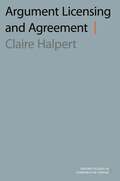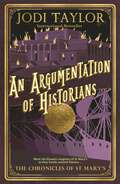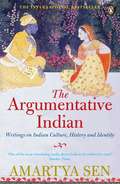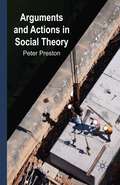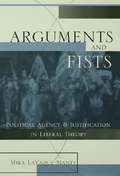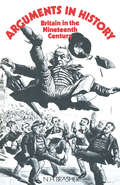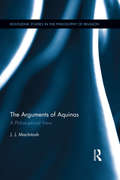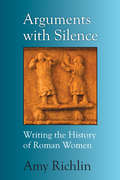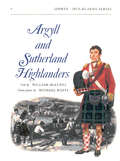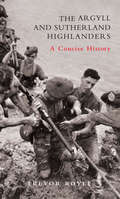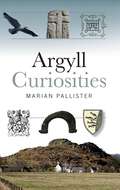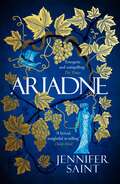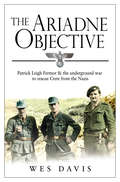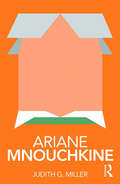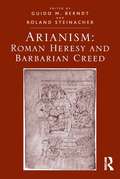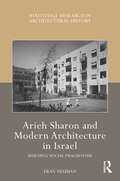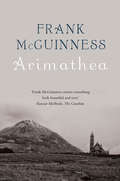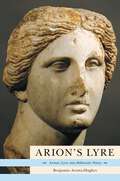- Table View
- List View
Argument Licensing and Agreement (Oxford Studies in Comparative Syntax)
by Claire HalpertThe strikingly unrestricted syntactic distribution of nouns in many Bantu languages often leads to proposals that syntactic case does not play an active role in the grammar of Bantu. This book offers a different conclusion that the basis of Zulu that Bantu languages have not only a system of structural case, but also a complex system of morphological case that is comparable to systems found in languages like Icelandic. By comparing the system of argument licensing found in Zulu to those found in more familiar languages, Halpert introduces a number of insights onto the organization of the grammar. First, while this book argues in favor of a case-licensing analysis of Zulu, it locates the positions where case is assigned lower in the clause than what is found in nominative-accusative languages. In addition, Zulu shows evidence that case and agreement are two distinct operations in the language, located on different heads and operating independently of each other. Despite these unfamiliarities, there is evidence that the timing relationships between operations mirror those found in other languages. Second, this book proposes a novel type of morphological case that serves to mask many structural licensing effects in Zulu; the effects of this case are unfamiliar, Halpert argues that its existence is expected given the current typological picture of case. Finally, this book explores the consequences of case and agreement as dissociated operations, showing that given this situation, other unusual properties of Bantu languages, such as hyper-raising, are a natural result. This exploration yields the conclusion that some of the more unusual properties of Bantu languages in fact result from small amounts of variation to deeply familiar syntactic principles such as case, agreement, and the EPP.
An Argumentation of Historians: The Chronicles Of St. Mary's Book Nine (Chronicles of St. Mary's #9)
by Jodi TaylorThe ninth book in the bestselling Chronicles of St Mary's series which follows a group of tea-soaked disaster magnets as they hurtle their way around History. If you love Jasper Fforde or Ben Aaronovitch, you won't be able to resist Jodi Taylor.They say you shouldn't push your luck. Max gives her own luck a massive shove every day - and it's only a matter of time until luck pushes back... January 1536 - the day of Henry VIII's infamous jousting accident. Historians from St Mary's are there in force, recording and documenting. And, arguing - obviously.A chance meeting between Max and the Time Police leads to a plan of action. And, it's one that will have very serious consequences - especially for Max. Her private life is already more than a little rocky. But with Leon recovering and Matthew safe in the future there will never be a better opportunity to bring down Clive Ronan, once and for all.From Tudor England to the burning city of Persepolis - and from a medieval siege to a very nasty case of 19th century incarceration - Max is determined that this time, he will not escape. Readers love Jodi Taylor: 'Once in a while, I discover an author who changes everything... Jodi Taylor and her protagonista Madeleine "Max" Maxwell have seduced me' 'A great mix of British proper-ness and humour with a large dollop of historical fun' 'Addictive. I wish St Mary's was real and I was a part of it' 'Jodi Taylor has an imagination that gets me completely hooked' 'A tour de force'
The Argumentative Indian: Writings on Indian History, Culture and Identity
by Amartya SenIndia is a very diverse country with many distinct pursuits, vastly different convictions, widely divergent customs, and a veritable feast of viewpoints. The Argumentative Indian brings together an illuminating selection of writings from Nobel prize-winning economist Amartya Sen that outline the need to understand contemporary India in the light of its long argumentative tradition. The understanding and use of this rich argumentative tradition are critically important, Sen argues, for the success of India's democracy, the defence of its secular politics, the removal of inequalities related to class, caste, gender and community, and the pursuit of sub-continental peace.
Arguments and Actions in Social Theory
by P. PrestonThis book argues that theorists are located within the social world; exercises in theorizing are both bounded and creative; imagination and creativity build upon the resources of tradition; and such awareness is the basis for dialogue with the denizens of other traditions, cultures and ways of making sense of the world.
Arguments and Fists: Political Agency and Justification in Liberal Theory
by Mika LaVaque MantyFirst published in 2002. Routledge is an imprint of Taylor & Francis, an informa company.
Arguments and Fists: Political Agency and Justification in Liberal Theory
by Mika LaVaque MantyFirst published in 2002. Routledge is an imprint of Taylor & Francis, an informa company.
The Arguments of Aquinas: A Philosophical View (Routledge Studies in the Philosophy of Religion)
by J.J. MacIntoshThe Arguments of Aquinas is intended for readers with philosophical interests, who may not be specialists in medieval philosophy. Some think that a medieval saint must be, as such, wrong, dated, and boring; others feel that a saint, any saint, must be right, relevant, and inspirational. Both groups are likely to misread Aquinas, if indeed they read him at all. The works of great philosophers are products of their times, but that does not lessen their value for us. We profit by reading the works of St Thomas in the same interested but critical way that we read the works of our contemporaries. MacIntosh does not hesitated to compare Thomas's arguments with those of later philosophers as well as with those of his contemporaries and earlier philosophers. He chooses topics from a variety of still interesting problem areas: the existence and attributes of God, including God's foreknowledge and human free will, causality and the origin of the universe, time and necessity, human souls, angels, and the problem of evil. Additionally, the volume looks at his views on honesty and lying, and on human sexuality, on which he is, as ever, philosophically interesting whether or not we accept his conclusions.
The Arguments of Aquinas: A Philosophical View (Routledge Studies in the Philosophy of Religion)
by J.J. MacIntoshThe Arguments of Aquinas is intended for readers with philosophical interests, who may not be specialists in medieval philosophy. Some think that a medieval saint must be, as such, wrong, dated, and boring; others feel that a saint, any saint, must be right, relevant, and inspirational. Both groups are likely to misread Aquinas, if indeed they read him at all. The works of great philosophers are products of their times, but that does not lessen their value for us. We profit by reading the works of St Thomas in the same interested but critical way that we read the works of our contemporaries. MacIntosh does not hesitated to compare Thomas's arguments with those of later philosophers as well as with those of his contemporaries and earlier philosophers. He chooses topics from a variety of still interesting problem areas: the existence and attributes of God, including God's foreknowledge and human free will, causality and the origin of the universe, time and necessity, human souls, angels, and the problem of evil. Additionally, the volume looks at his views on honesty and lying, and on human sexuality, on which he is, as ever, philosophically interesting whether or not we accept his conclusions.
Arguments with Silence: Writing the History of Roman Women
by Amy RichlinWomen in ancient Rome challenge the historian. Widely represented in literature and art, they rarely speak for themselves. Amy Richlin, among the foremost pioneers in ancient studies, gives voice to these women through scholarship that scours sources from high art to gutter invective. In Arguments with Silence, Richlin presents a linked selection of her essays on Roman women’s history, originally published between 1981 and 2001 as the field of “women in antiquity” took shape, and here substantially rewritten and updated. The new introduction to the volume lays out the historical methodologies these essays developed, places this process in its own historical setting, and reviews work on Roman women since 2001, along with persistent silences. Individual chapter introductions locate each piece in the social context of Second Wave feminism in Classics and the academy, explaining why each mattered as an intervention then and still does now. Inhabiting these pages are the women whose lives were shaped by great art, dirty jokes, slavery, and the definition of adultery as a wife’s crime; Julia, Augustus’ daughter, who died, as her daughter would, exiled to a desert island; women wearing makeup, safeguarding babies with amulets, practicing their religion at home and in public ceremonies; the satirist Sulpicia, flaunting her sexuality; and the praefica, leading the lament for the dead. Amy Richlin is one of a small handful of modern thinkers in a position to consider these questions, and this guided journey with her brings surprise, delight, and entertainment, as well as a fresh look at important questions.
Argyll and Sutherland Highlanders (Men-at-Arms #3)
by William McElwee Michael RoffeOn 1 July 1881 Viscount Cardwell's wholesale reorganisation of the British Army brought into existence Priness Louise's Argyll and Sutherland Highlanders. Both had existed as separate regiments even before their official incorporation into the British Army and on the face of it, this seemed a highly improbable union, Being separated both geographically and historically they had never even served together in the same theatre. Yet, as history has shown, this unlikely combination proved to be a tremendous success. William McElwee tells the story of this most famous of regiments which has served with distinction in two world wars and beyond.
The Argyll and Sutherland Highlanders: A Concise History
by Trevor RoyleThe Argyll and Sutherland Highlanders is one of the best-known regiments in the British Army. In a previous incarnation as the 93rd Highlanders, its soldiers were famed for being the 'thin red line' that repulsed the Russian heavy cavalry at the Battle of Balaklava during the Crimean War. When the regiment was ordered to disband in 1968 as part of wide-ranging defence cuts, a popular 'Save the Argylls' campaign was successful in keeping the regiment in being. In 2006, it became the 5th battalion of the new Royal Regiment of Scotland.Formed by two earlier regiments, The Argylls have a stirring history of service to the British Crown. They served all over the empire, taking part in the Indian Mutiny and the Boer War, and fought in both World Wars. In the post-war period the Argylls captured the public imagination in 1967 when they reoccupied the Crater district of Aden following a period of riots.Recruiting mainly from the west of Scotland, the regiment has a unique character and throughout its history has retained a fierce regimental pride which is summed up by its motto: 'sans peur', meaning 'without fear'. The Argyll and Sutherland Highlanders puts its story into the context of British military history and makes use of personal testimony to reveal the life of the regiment.
Argyll Curiosities
by Marian PallisterThe great travellers of the 17th century - Martin, Penant, Johnson et al - used the word ‘curiosity’ to mean many different things. They labelled as ‘curiosities’ people, plants, legends, historical facts and geological certainties. Argyll Curiosities follows their example in a 21st century journey around Argyll and its islands.It is difficult to find an area of Argyll which is not curious in some way: archaeology, geography, geology and genealogy have all served to mark out this western fringe of Scotland as unique. Discarding those curiosities which it is all too easy to find on any journey through the county, Marian Pallister has looked extensively into places, people and events which are curiously layered, and has created a book that is overflowing with enchanting ‘curiosities’ and local histories.
Ariadne: The Brilliant Feminist Debut that Everyone is Talking About
by Jennifer SaintA mesmerising retelling of the ancient Greek myth of Theseus and the Minotaur. Perfect for fans of CIRCE, A SONG OF ACHILLES, and THE SILENCE OF THE GIRLS.'ARIADNE gives voice to the misused Princess of Crete who betrayed her father to save Theseus from the Minotaur. Relevant and revelatory.' - StylistAs Princesses of Crete and daughters of the fearsome King Minos, Ariadne and her sister Phaedra grow up hearing the hoofbeats and bellows of the Minotaur echo from the Labyrinth beneath the palace. The Minotaur - Minos's greatest shame and Ariadne's brother - demands blood every year. When Theseus, Prince of Athens, arrives in Crete as a sacrifice to the beast, Ariadne falls in love with him. But helping Theseus kill the monster means betraying her family and country, and Ariadne knows only too well that in a world ruled by mercurial gods - drawing their attention can cost you everything. In a world where women are nothing more than the pawns of powerful men, will Ariadne's decision to betray Crete for Theseus ensure her happy ending? Or will she find herself sacrificed for her lover's ambition?ARIADNE gives a voice to the forgotten women of one of the most famous Greek myths, and speaks to their strength in the face of angry, petulant Gods. Beautifully written and completely immersive, this is an exceptional debut novel.Praise for Jennifer Saint and ARIADNE:'With her wonderfully executed debut that reimagines the classic tale of Theseus, Adriane and the Minotaur, Jennifer Saint joins the likes of Madeline Miller and Pat Barker in forging mesmerising retellings of ancient Greek myths from a female perspective.' - Waterstones.com'Saint's immersive novel thrusts the reader straight into the heart of Greek mythology with this wonderful reimagining of the story of Ariadne.' - iPaper'What happens after the monster is defeated and the princess leaves with the hero? Jennifer Saint's ARIADNE is a shimmering tapestry of two sisters bound by deceit and the shadows of family history. . .With a fresh voice and keen insight, Saint adds flesh and bone to an ancient myth, drawing the reader into an uneasy world of ever-afters.' - Yangsze Choo, New York Times bestselling author of THE NIGHT TIGER
The Ariadne Objective: Patrick Leigh Fermor and the Underground War to Rescue Crete from the Nazis
by Wes DavisIn the bleakest years of the Second World War when it appeared that nothing could slow the advance of the German army, Hitler set his sights on the Mediterranean island of Crete, the ideal staging ground for domination of the Middle East. But German command had not counted on the strength of the Cretan resistance or the eccentric band of British intelligence officers who would stand in their way, conducting audacious sabotage operations in the very shadow of the Nazi occupation force.The Ariadne Objective tells the remarkable story of the secret war on Crete from the perspective of these amateur soldiers who found themselves serving because, as one of them put it, they had made 'the obsolete choice of Greek at school'. John Pendlebury, a swashbuckling archaeologist with a glass eye and a swordstick; Xan Fielding, a writer who would later produce the English translations of books like Bridge on the River Kwai and Planet of the Apes; Sandy Rendel, a future Times reporter, who prided himself on a disguise that left him looking more ragged and fierce than the Cretans he fought alongside; and Patrick Leigh Fermor, the future travel-writing luminary who, as a teenager in the early 1930s, walked across Europe, a continent already beginning to feel the effects of Hitler's rise to power.Having infiltrated occupied Crete, these British gentleman spies teamed with Cretan partisans to carry out a cunning plan to disrupt Nazi manoeuvres, culminating in a daring, high-risk plot to abduct the island’s German commander. In this thrilling and little known episode of Second World War history, Wes Davis paints a brilliant portrait of some extraordinary characters and tells a story of triumph against all the odds.
Ariane Mnouchkine (Routledge Performance Practitioners)
by Judith MillerOver the last forty years, French director Ariane Mnouchkine and her theater collective, Le Théâtre du Soleil, have devised a form of research and creation that is both engaged with contemporary history and committed to reinvigorating theater by focusing on the actor. Now revised and reissued, this volume combines: ● an overview of Mnouchkine’s life, work and theatrical influences ● an exploration of her key ideas on theater and the creative process ● analysis of key productions, including her early and groundbreaking environmental political piece, 1789, and the later Asian-inspired play penned by Hélène Cixous, Drums on the Dam. ● practical exercises, including tips on mask work. As a first step toward critical understanding, and as an initial exploration before going on to further, primary research, Routledge Performance Practitioners offer unbeatable value for today’s student.
Ariane Mnouchkine (Routledge Performance Practitioners)
by Judith MillerOver the last forty years, French director Ariane Mnouchkine and her theater collective, Le Théâtre du Soleil, have devised a form of research and creation that is both engaged with contemporary history and committed to reinvigorating theater by focusing on the actor. Now revised and reissued, this volume combines: ● an overview of Mnouchkine’s life, work and theatrical influences ● an exploration of her key ideas on theater and the creative process ● analysis of key productions, including her early and groundbreaking environmental political piece, 1789, and the later Asian-inspired play penned by Hélène Cixous, Drums on the Dam. ● practical exercises, including tips on mask work. As a first step toward critical understanding, and as an initial exploration before going on to further, primary research, Routledge Performance Practitioners offer unbeatable value for today’s student.
Arianism: Roman Heresy And Barbarian Creed
by Guido M. BerndtThis is the first volume to attempt a comprehensive overview of the evolution of the 'Arian' churches in the Roman world of Late Antiquity and their political importance in the late Roman kingdoms of the 5th-6th centuries, ruled by barbarian warrior elites. Bringing together researchers from the disciplines of theology, history and archaeology, and providing an extensive bibliography, it constitutes a breakthrough in a field largely neglected in historical studies. A polemical term coined by the Orthodox Church (the side that prevailed in the Trinitarian disputes of the 4th century C.E.) for its opponents in theology as well as in ecclesiastical politics, Arianism has often been seen as too complicated to understand outside the group of theological specialists dealing with it and has therefore sometimes been ignored in historical studies. The studies here offer an introduction to the subject, grounded in the historical context, then examine the adoption of Arian Christianity among the Gothic contingents of the Roman army, and its subsequent diffusion in the barbarian kingdoms of the late Roman world.
Arianism: Roman Heresy and Barbarian Creed
by Guido M. BerndtThis is the first volume to attempt a comprehensive overview of the evolution of the 'Arian' churches in the Roman world of Late Antiquity and their political importance in the late Roman kingdoms of the 5th-6th centuries, ruled by barbarian warrior elites. Bringing together researchers from the disciplines of theology, history and archaeology, and providing an extensive bibliography, it constitutes a breakthrough in a field largely neglected in historical studies. A polemical term coined by the Orthodox Church (the side that prevailed in the Trinitarian disputes of the 4th century C.E.) for its opponents in theology as well as in ecclesiastical politics, Arianism has often been seen as too complicated to understand outside the group of theological specialists dealing with it and has therefore sometimes been ignored in historical studies. The studies here offer an introduction to the subject, grounded in the historical context, then examine the adoption of Arian Christianity among the Gothic contingents of the Roman army, and its subsequent diffusion in the barbarian kingdoms of the late Roman world.
Arieh Sharon and Modern Architecture in Israel: Building Social Pragmatism (Routledge Research in Architectural History)
by Eran NeumanArieh Sharon and Modern Architecture in Israel: Building Social Pragmatism offers the first comprehensive survey of the work of Arieh Sharon and analyzes and discusses his designs and plans in relation to the emergence of the State of Israel. A graduate of the Bauhaus, Sharon worked for a few years at the office of Hannes Mayer before returning to Mandatory Palestine. There, he established his office which was occupied in its first years in planning kibbutzim and residential buildings in Tel Aviv. After the establishment of the State of Israel in 1948, Arieh Sharon became the director and chief architect of the National Planning Department, where he was asked to devise the young country’s first national masterplan. Known as the Sharon Plan, it was instrumental in shaping the development of the new nation. During the 1950s and 1960s, Sharon designed many of Israel’s institutions, including hospitals and buildings on university campuses. This book presents Sharon’s exceptionally wide range of work and examines his perception of architecture in both socialist and pragmatist terms. It also explores Sharon’s modernist approach to architecture and his subsequent shift to Brutalist architecture, when he partnered with Benjamin Idelson in the 1950s and when his son, Eldar Sharon, joined the office in 1964. Thus, the book contributes a missing chapter in the historiography of Israeli architecture in particular and of modern architecture overall. This book will be of interest to researchers in architecture, modern architecture, Israel studies, Middle Eastern studies and migration of knowledge.
Arieh Sharon and Modern Architecture in Israel: Building Social Pragmatism (Routledge Research in Architectural History)
by Eran NeumanArieh Sharon and Modern Architecture in Israel: Building Social Pragmatism offers the first comprehensive survey of the work of Arieh Sharon and analyzes and discusses his designs and plans in relation to the emergence of the State of Israel. A graduate of the Bauhaus, Sharon worked for a few years at the office of Hannes Mayer before returning to Mandatory Palestine. There, he established his office which was occupied in its first years in planning kibbutzim and residential buildings in Tel Aviv. After the establishment of the State of Israel in 1948, Arieh Sharon became the director and chief architect of the National Planning Department, where he was asked to devise the young country’s first national masterplan. Known as the Sharon Plan, it was instrumental in shaping the development of the new nation. During the 1950s and 1960s, Sharon designed many of Israel’s institutions, including hospitals and buildings on university campuses. This book presents Sharon’s exceptionally wide range of work and examines his perception of architecture in both socialist and pragmatist terms. It also explores Sharon’s modernist approach to architecture and his subsequent shift to Brutalist architecture, when he partnered with Benjamin Idelson in the 1950s and when his son, Eldar Sharon, joined the office in 1964. Thus, the book contributes a missing chapter in the historiography of Israeli architecture in particular and of modern architecture overall. This book will be of interest to researchers in architecture, modern architecture, Israel studies, Middle Eastern studies and migration of knowledge.
Arimathea
by Frank McGuinness'The great spirit of Frank McGuinness radiates in this magnificent novel. Myriad voices converge on one glistening core; it is a high-wire act earthed in the deepest humanity.' Sebastian Barry It is 1950. Donegal. A land apart. Derry city is only fourteen miles away but far beyond daily reach. Into this community comes Gianni, also called Giotto at his birth. A painter from Arrezzo in Italy, he has been commissioned to paint the Stations of the Cross. The young Italian comes with his dark skin, his unusual habits, but also his solitude and his own peculiar personal history. He is a major source of fascination for the entire community. A book of close observation, sharp wit, linguistic dexterity – and of deep sympathy for ordinary, everyday humanity.
Arion's Lyre: Archaic Lyric into Hellenistic Poetry (PDF)
by Benjamin Acosta-HughesArion's Lyre examines how Hellenistic poetic culture adapted, reinterpreted, and transformed Archaic Greek lyric through a complex process of textual, cultural, and creative reception. Looking at the ways in which the poetry of Sappho, Alcaeus, Ibycus, Anacreon, and Simonides was preserved, edited, and read by Hellenistic scholars and poets, the book shows that Archaic poets often look very different in the new social, cultural, and political setting of Hellenistic Alexandria. For example, the Alexandrian Sappho evolves from the singer of Archaic Lesbos but has distinct associations and contexts, from Ptolemaic politics and Macedonian queens to the new phenomenon of the poetry book and an Alexandrian scholarship intent on preservation and codification. A study of Hellenistic poetic culture and an interpretation of some of the Archaic poets it so lovingly preserved, Arion's Lyre is also an examination of how one poetic culture reads another--and how modern readings of ancient poetry are filtered and shaped by earlier readings.
Arion's Lyre: Archaic Lyric into Hellenistic Poetry
by Benjamin Acosta-HughesArion's Lyre examines how Hellenistic poetic culture adapted, reinterpreted, and transformed Archaic Greek lyric through a complex process of textual, cultural, and creative reception. Looking at the ways in which the poetry of Sappho, Alcaeus, Ibycus, Anacreon, and Simonides was preserved, edited, and read by Hellenistic scholars and poets, the book shows that Archaic poets often look very different in the new social, cultural, and political setting of Hellenistic Alexandria. For example, the Alexandrian Sappho evolves from the singer of Archaic Lesbos but has distinct associations and contexts, from Ptolemaic politics and Macedonian queens to the new phenomenon of the poetry book and an Alexandrian scholarship intent on preservation and codification. A study of Hellenistic poetic culture and an interpretation of some of the Archaic poets it so lovingly preserved, Arion's Lyre is also an examination of how one poetic culture reads another--and how modern readings of ancient poetry are filtered and shaped by earlier readings.
The Arisaka Rifle (Weapon)
by Bill HarrimanEntering service in 1897, the Arisaka family of bolt-action rifles armed Japanese troops and others through two world wars and many other conflicts, including the Russo-Japanese War of 1904–05. Issued in long and short versions – the latter for cavalry and specialists – the Type 30 was the first main Arisaka model, arming Imperial Japan's forces during the Russo-Japanese War, though after the war it was refined into the Type 38, which would still be in use in 1945. The main Arisaka rifle of World War II though was the Type 99. Lighter and more rugged than the US M1903 Springfield rifle it would face in the initial battles in the Pacific, it was produced in four main variants, including a sniping model and a take-down parachutist's rifle. Featuring full-colour artwork as well as archive and close-up photographs, this is the absorbing story of the rifles arming Imperial Japan's forces, from the trenches of Mukden in 1905 to the beaches of Okinawa 40 years later.
